My new book of visual poetry is now available at Trickhouse Press.
The blurb and some praise for the book:

My new book of visual poetry is now available at Trickhouse Press.
The blurb and some praise for the book:

Filed under Art, avant-garde, contemporary art, Dada, Earth, Environmentalism, imagination, natural world, Nature, poetry, Psychogeography, sea, Short Fiction, the sea, vispo, visual poetry
Metal is often seen as cold, hard and inert, but one artist has found a way to adapt the material so it appears loose, alive and free. British artist Penny Hardy makes life-sized human sculptures from discarded metal, each one exploring an emotion or experience. These are installed in open-air settings, in fields or gardens or overlooking water.
Hardy originally trained as a scientific illustrator, which taught her to examine the intricacies of natural forms and observational draftsmanship. Throughout her consequent working life alongside architects and designers, she developed a deep interest in three-dimensional forms. These skills informed her later work as a sculptor—and here she is self-taught over the last fifteen years.
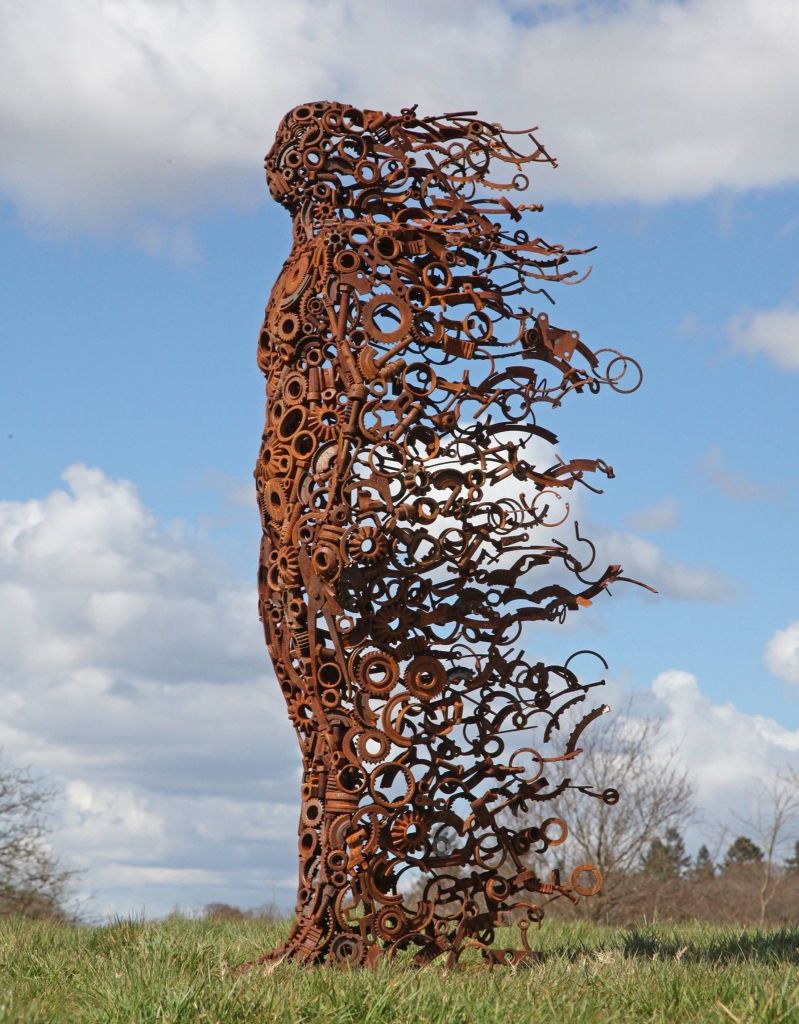
She was drawn to creating human forms out of discarded objects and seems particularly attuned to a sense of movement and energy within material form, capturing these in all her pieces, transforming inert materials into sculptures with a tangible energy. ‘The sense of movement and dynamics within sculpture provides it with its own life and vitality,’ Hardy states.
In the Blown Away series, she chose to use old metal machinery parts because these were made to be resilient and strong, yet were thrown away at the slightest hint of failure. Hardy felt that these imperfect pieces should be recycled to show some of the effects machinery has had on our lives and the environment. She says, ‘By using discarded, man-made metal items—which have been so skillfully made and used to create their own mechanical energy—I hope to extend their life in another form, re-use that energy for a different purpose, and exchange their function to create a new entity.’ You Blew Me Away (159cm x 75cm x 55cm) and Erosion (159cm x 45cm x 45cm) are examples.
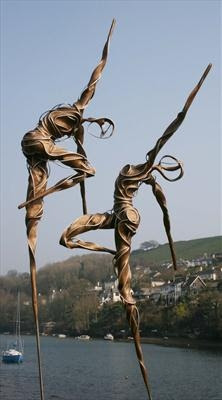
Hardy’s dance figures are wonderful affirmations of life and movement. Inspired by the dynamic forms of contemporary dancers, they use a flexible material like aluminium to re-create a visual sense of movement. Angels in Harlem (300cm x 200cm x 750cm), for instance, is a sculpture on stilts designed to gently sway in any breeze, creating a sense of constant movement.
Hardy has exhibited throughout the UK since her first public exhibition of dance sculptures in 2006, including at Doddington Hall, Hill House Dartington and Royal West of England Academy. More about the artist can be found on her website here
Filed under Art, Arts, contemporary art, Earth, Environmentalism, installation, installation art, land art, public art, Sculpture, Uncategorized
In the period since ww2, art that involves nature or natural processes has taken diverse forms, from the huge spiral artworks of Robert Smithson created on the shore of the great Salt Lakes, to the walks of Richard Long through the English landscape, to Andy Goldsworthy’s ephemeral leaf or ice sculptures in outdoor settings. Within such art, there has always been the question: is the immediate experience of the natural world translatable into a gallery? As artists still want their work to be seen and thought about, for better or worse the gallery is the best place – whether in the form of exquisite photographs (eg of Goldsworthy’s sculptures), photographs taken with indifference to art or framing (eg of Smithson’s Spiral Jetty), or data about a walk offering ‘evidence’ of the artwork (eg Long).
Anya Gallaccio (born 1963, UK) has an intriguing way of including natural processes within gallery-based artwork. She creates site-specific installations, often using organic matter such as flowers, fruit, ice, wax and chocolate. An artist who came of age at the same time as the more famous Damien Hirst, Gallaccio challenges the traditional idea that artworks should be a monument within a museum or a gallery; she makes art which changes over time, rotting, melting, being oxydised. It is art about ‘process’ as much as ‘object’, like an unruly experiment, the end result of which cannot be predicted; and as such it is hard to document with a simple photograph – being principled, she refuses to take photos of her own art to sell. She also emphasises the personal experience of the viewer: her work lives on not as photographs that she exhibits but as memories in those who experienced it as well as in the idea of the artwork itself. The emphasis on personal experience puts one in mind of Anthony Gormley’s perceptive comment that art is about ‘reasserting our first hand experience in present time’.
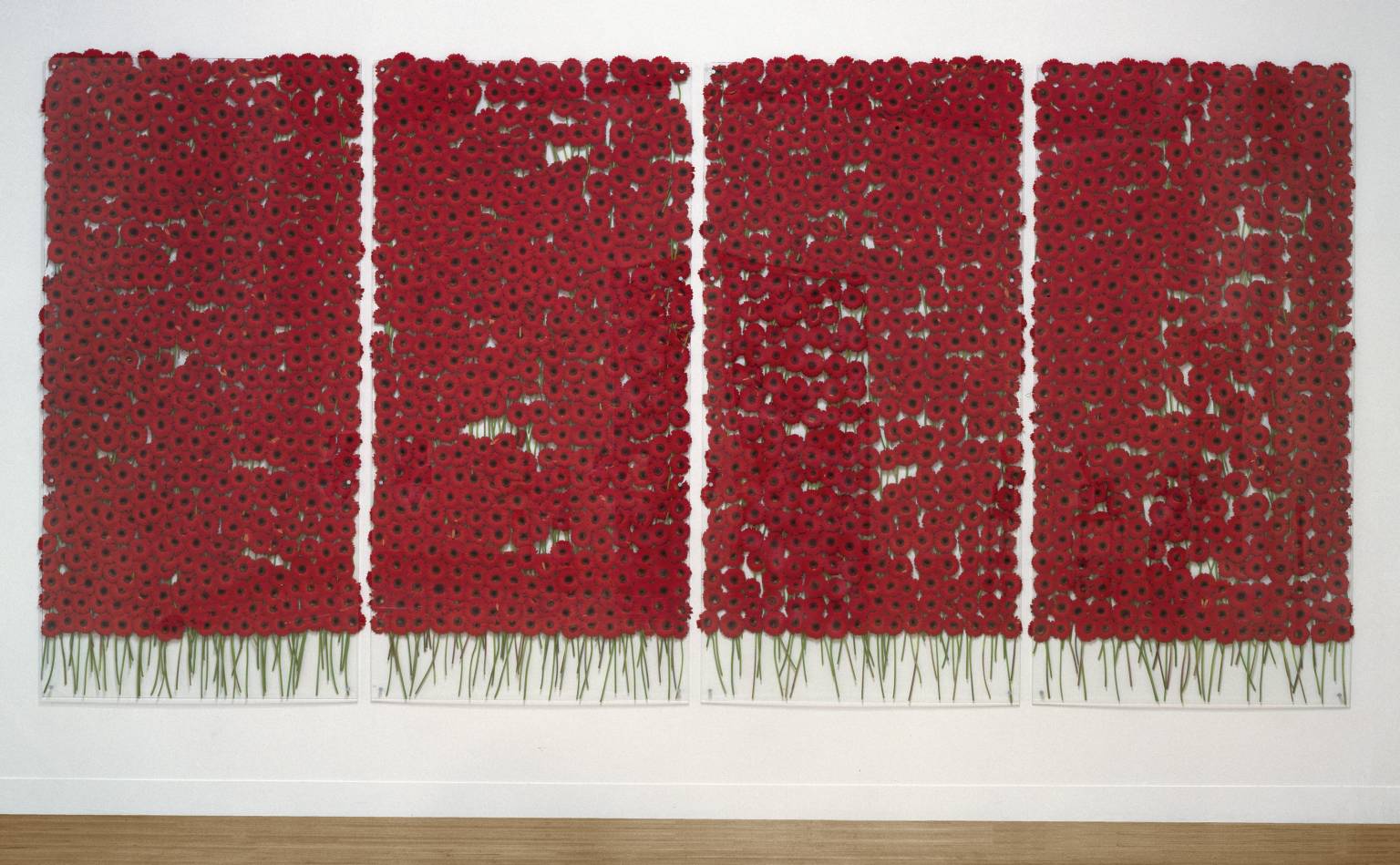
preserve ‘beauty’ 1991-2003

Preserve Beauty 1991-2003
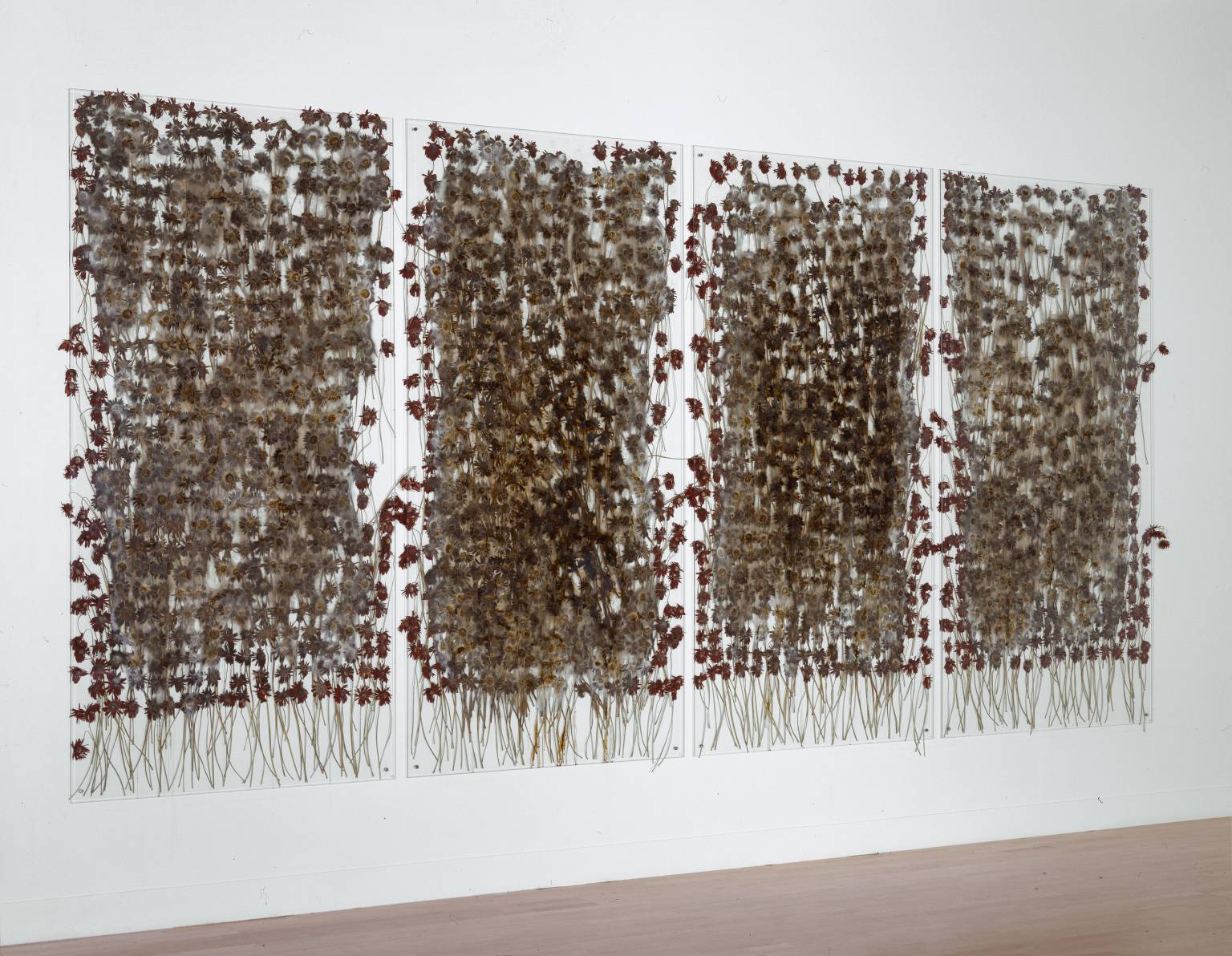
Preserve Beauty 1991-2003
Some of Gallaccio’s artworks have been repeated at different sites. In ‘Preserve Beauty’ (1991-2003), between 1600 and 2000 red gardenias are arranged in four adjacent rectangular compositions underneath large panes of clear glass, with the flower heads facing out towards the viewer. Over time, the gardenias wither and die; as well as changes to the appearance of the work, there are changes to the smell in the gallery, and some flowers even fall out to rot on the floor. ‘Preserve Beauty’ has echoes of Dutch vanitas paintings of the 16th/17th century, which contained collections of objects symbolic of life’s transience and death’s inevitability – a meditation on decay, change, mortality.
The red gardenias, a mix of gerbera and daisies, are grown for commercial consumption and thus are a type of readymade according to Gallaccio – an everyday, often scentless and mass-produced object. These flowers are chosen as they blur the gap between ‘the natural’ and objects of a commodity culture. She explores this overlap between natural objects and those of disposable commodity culture, specifically in relation to the wastage and decay that is usually hidden from consumers. She has stated that, ‘we experience so much of the world at a mediated and sanitised distance, so I try to make art that is not complicit with this structure’.
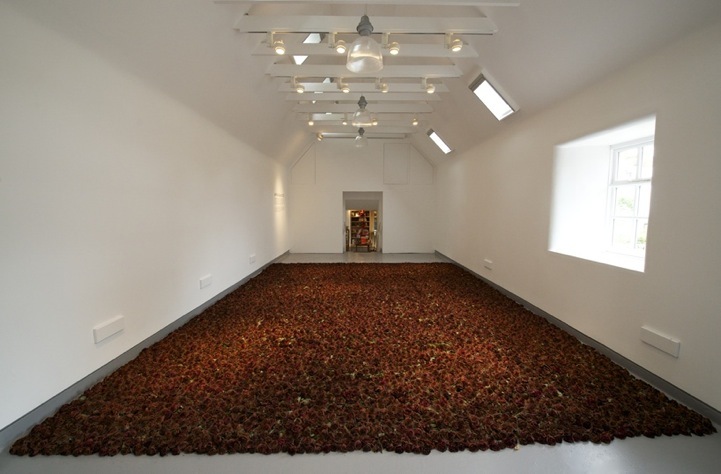
Red on Green 2012
In ‘Red on Green’ (2012) Gallaccio plucked the heads of 10,000 red roses and arranged them into large rectangle on a gallery floor. At first the installation might seem like a grand romantic gesture. However, Gallaccio’s interest is piqued in what the installation becomes over time. In a way, ‘Red on Green’ becomes a kind of natural performance as the field of red shifts to brown. The symbol of the rose is used as a starting point for meditating on the natural processes of death and decay.
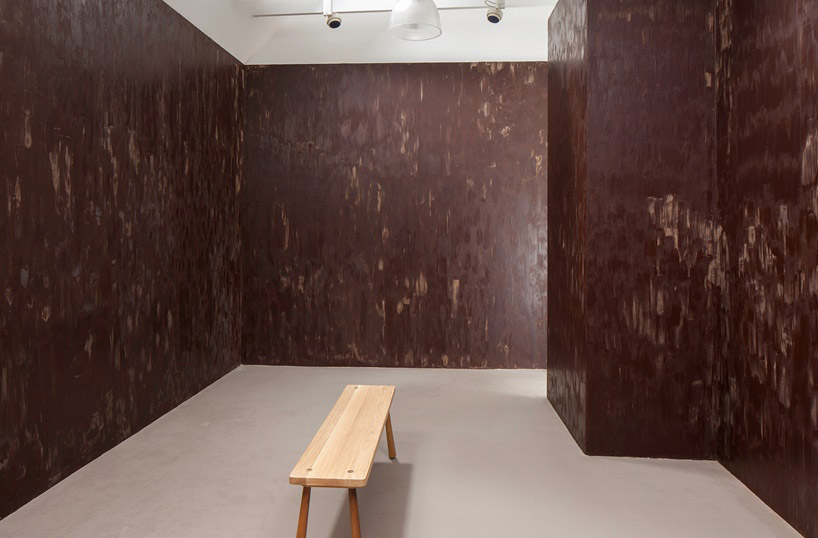
Stroke 1994
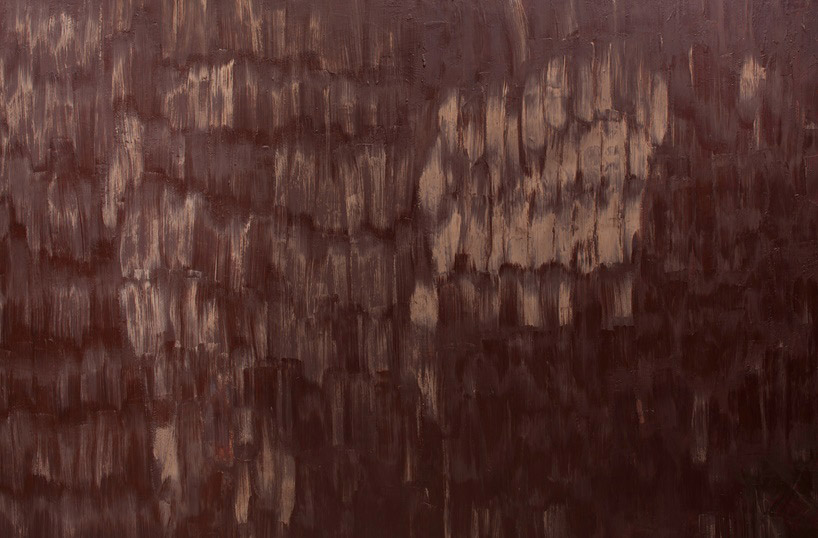
For her installation ‘Stroke’ (2014-15), she constructed a room made of dark chocolate, inviting visitors to lick the walls if they so dared. The room was partly intended to be a feminine space in an art-world defined mostly by men: the artist sees her unusual material as one normally associated with the female domain and she thus brings the domestic out of the shadows, into the public arena. Painted in thick, gentle layers of chocolate, the room was dark and cavernous, a space to be entered into and experienced. The piece relied upon the viewer drawing meanings from the artwork, though it was as much about fantasy and anticipation as the actual (disappointing) experience of sitting in a chocolate room. As the artist explained, the real chocolate room was distinct from what one might have expected. As time wore on, the sweet odour turned sour; the chocolate, painted onto the walls, oxidised; insects moved into the space. More an encounter with decay and discomfort than with sensual pleasure.
Other works include Glaschu (1999), in which a pattern outline from a paisley carpet, drawn from flowers and foliage, pierces a thinly poured layer of cement floor in an elegant neo-classical interior, so that living verdure creeps from the meandering cracks. The theme of nature reclaiming its territory from human ruins is poignant.
More about Gallaccio can be found here https://www.blumandpoe.com/artists/anya-gallaccio
Filed under Art, Arts, contemporary art, Earth, imagination, installation, installation art, land art, Performance art, public art, Uncategorized
The Australian artist Bromwyn Berman makes public and installation art as well as sculpture, drawings and paintings. Her alluring works relate intimately to, and reflect on, the natural world. The art seeks to ‘encourage a respect for our place in the evolution of landscape as part of the processes of nature.’ Organic signs and symbols recur – spirals, circles, pods, mandalas, honeycomb forms – and she uses a variety of materials, including copper wire, aluminium, stainless steel, stones, mulberry paper, bees wax, tree roots, charcoal, plant remains from rivers. These natural and man-made materials ‘evidence our interface with nature.’

Windspiral 2006
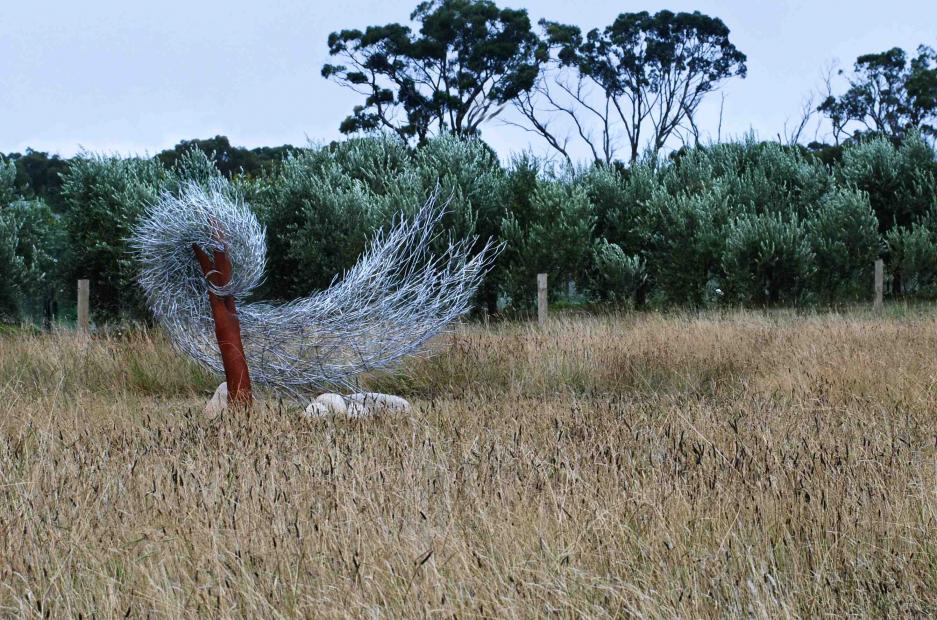
Her public artworks and larger sculptural installations focus on landscape and natural systems; they speak to what she calls ‘our inner knowing of the earth body.’ Her studio practice, paper works, drawings and small sculpture explore ‘the simplest and most basic signifiers of natural systems’; they inquire into ‘archetypal forms of geometry as well as themes of the recurring mysteries that form the foundation of our experience.’ She believes in a deep collective consciousness, which art can put humans in touch with. Some might say this puts her within a visionary or spiritual aesthetic tradition, though her work is viscerally grounded, in roots, branches, copper wire, mulberry paper.
The breathtaking ‘Windspiral’ (2006), made of aluminium and stainless steel with timber support (120cm x 300cm x 300cm), was installed at the Sculpture by the Sea exhibition, Sydney, 2006. Berman says, ‘The shape is that of the wind, the colour and texture are the Australian bush where things are silvery and scratchy.’ The inspiration for this work came from living high on a cliff in the Australian bush as well a joyful day spent making artwork with a friend in this special windy place. She has made various other ‘Windspirals’ for different locations.
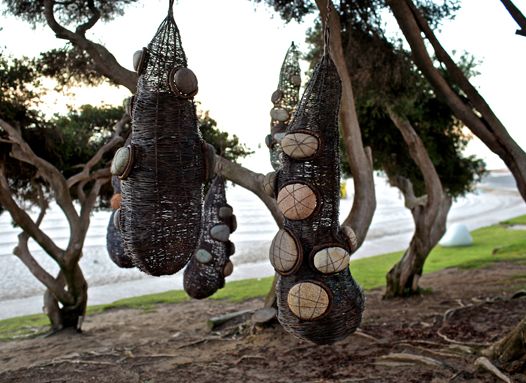
Banksia Women
Her series of ‘Banksia Women’ (2011), pods woven from copper with river stones (140cm x 50cm x 50cm), were exhibited in various locations across Australia. The pod, Berman believes, is a deeply ‘known’ form, an ‘encapsulation of life to come, a concentration or distillation of all that is complex in nature, containing seeds of new life or… the promise of transformation to new form.’

The Portal
‘The Portal’ (2013) is a circle of aluminium and stainless steel (120cm x 120cm x 20cm) suspended in woodland. Again, we have an organic form that may elicit a response from an ‘inner knowing’; and a form that suggests a liminal place or doorway with all the associations of transition and transformation. The work was exhibited at Sculpture at Scenic World, 2013.
Her ‘River to River: Interwoven Landscapes’ exhibitions at the Penrith Regional Gallery, Australia (2014), included various wonderfully titled sculptures and artworks: ‘Murmurings’ (215cm x 215cm x 30cm) is a mandala made from fragments of Casurina (River Oak) roots nailed onto paper; ‘There is another alphabet’ (25cm x 22cm x13cm) is made of Japanese mulberry paper, Moulin Delaroc paper and waxed Linen thread, with the paper contact-printed with plants from the Nepean River; and ‘You and I have floated on the stream’ (300cm x 60cm x 50cm) is an animated river of paper contact-printed with plants from the Nepean River and with Casurina roots.

The Murmurings 2014

There is another alphabet 2014

You and I have floated on the stream
Berman’s beautiful, enigmatic art changes the viewer, inspires them and engenders reflection; her pieces speak of the natural world and our place within it, using a language rooted in a material alphabet, one of paper, tree branches, thread, wax.
More about the artist can be found on her website (where quotes here were taken from) http://www.bronwynberman.com.au
Filed under Art, Arts, contemporary art, Earth, Environmentalism, imagination, installation art, Myth, natural world, Nature, Photography, Psychogeography, public art, River, Sculpture, Uncategorized
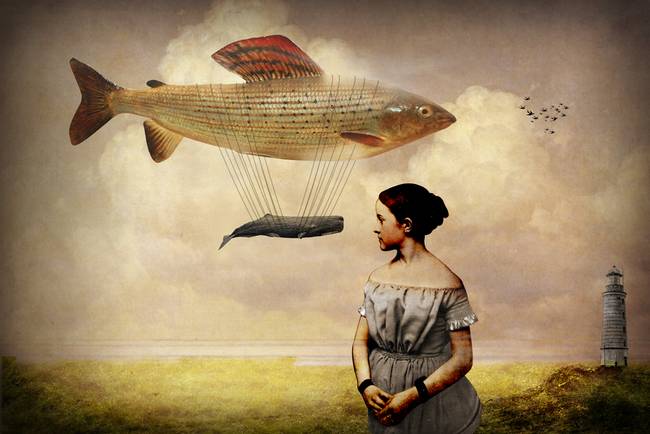
Catrin Welz-Stein creates strange, magical images from combining old photo fragments, paintings and illustrations. She originally trained as a graphic designer and illustrator in Germany and then worked in graphic design. During a break from work to bring up children, she began in 2009 to create images based on digital collaging in Photoshop. She has said she felt compromised by professional graphic design, having to make art that is ‘forced to explain itself from the beginning’. In Photoshop she began to produce images with a dreamlike quality instead, an art that comes from ‘inner feeling which we hide in our daily lives’. The time spent with her children also re-introduced her to fairy tales and the fantasy of children’s literature.
Welz-Stein’s work draws on the many photographs, paintings and illustrations that she stores on her computer. She produces the images by cutting, copying, transforming little pieces of images and blending them with others, sewing all the fragments together to create something new. Motifs recur: keys, moons, birds, flowers, leaves, trees, bird cages, fish, words, houses, butterflies, water, balloons. Each image tends to focus around one figure (sometimes a few figures), predominantly women, though there are men, children and birds, too. Around, and sometimes within, the figure, fabulous and odd things take place: a woman stares at a huge fish floating across the sky with a whale roped to its underbelly; a girl walks across a tightrope high above a city, holding the earth as a balloon; a woman’s long hair protrudes almost horizontally behind her, and from it hangs a moon, a cloud, a bird cage; a man in a top hat stands beneath a streetlight, the light inside which is the crescent moon. The costumes worn by the figures are often extravagant: a woman’s dress is made from flowers or leaves or buildings, a girl wears an Edwardian dress with keys dangling from its rear.

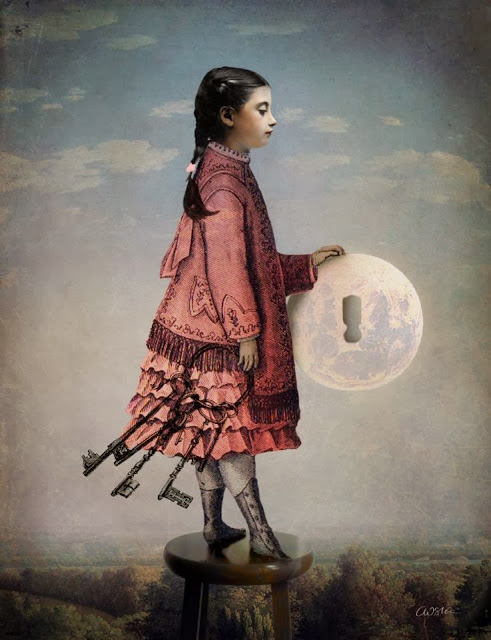
The images engender a poetic world reminiscent of fairy tales and surrealism; some are unsettling, others more whimsical. Each picture seems to tell a fragment of a story, one based on an unconscious truth. Welz-Stein cites her contemporary influences as artists and illustrators like Kelly Rae Roberts, Okaf Hajek and Natalie Shou; more historical influences include Botticelli, Otto Dix, Rene Magritte, Frida Kahlo and Gustav Klint . Certainly Magritte’s impact is evident, with his depictions of ordinary objects in a strange context to engender poetic realities; and that of Frida Kahlo too, with her women in odd scenarios, dressed in extravagant costumes, closely linked to the earth, vegetation and animals.


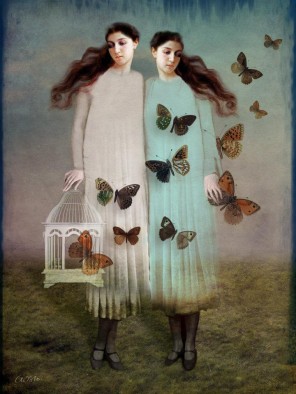
Catrin Welz-Stein’s work became well known through social media. She now has 27K likes on Facebook and over 2000 followers on Instagram. More about her can be found from her website http://catrinwelzstein.blogspot.am/
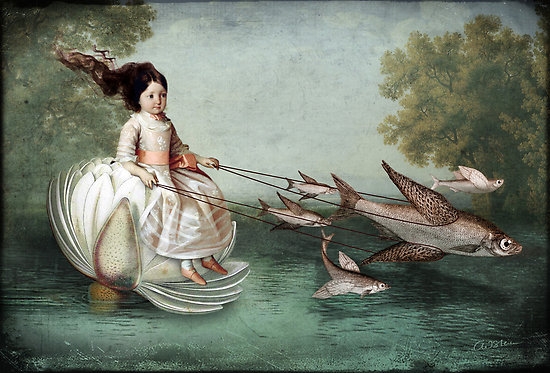
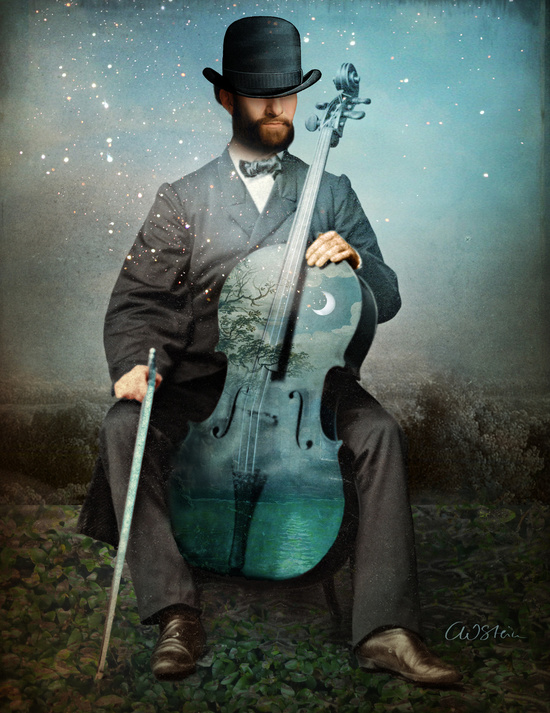
Filed under Art, Arts, contemporary art, Earth, Environmentalism, imagination, Myth, natural world, Nature, Photography, poetry, River, the sea, Uncategorized
Chris Drury (1948-) is a British artist who creates site-specific land art and installation art using natural materials which are locally sourced. He also produces videos, sculpture, mixed media works, prints, and paintings. His work explores the connection between realms – nature and culture, microcosm and macrocosm, the inner and the outer, the fluid and the static. He likes to work collaboratively – with scientists, technicians, native peoples, anthropologists, geologists – and his work reflects on the nature of place and of humans within that.
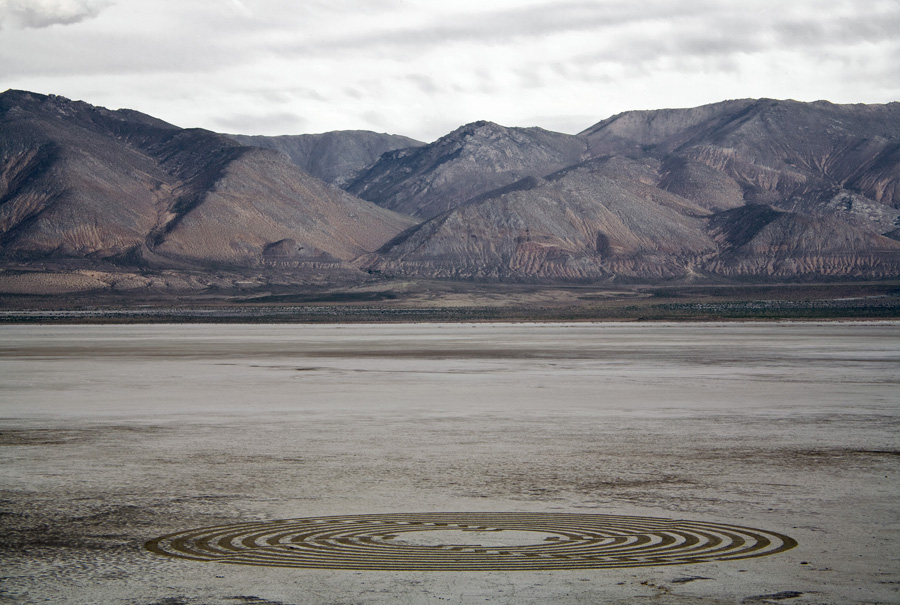
Winnemucca Whirlwind, 2008
Drury came of age at a time of land art giants such as Robert Smithson (1938-73). Like Smithson, his art addresses our relationship to the natural world, meditating on ecological, historical, and cultural themes. Winnemucca Whirlwind (2008), a work 300 feet across and based on a native American basket design, was raked by hand (over 18 hours) into the dry lakebed of Lake Winnemucca, Nevada. Although placed on Government land, it was only visible from a high point on the Paiute Indian Reservation. The work eventually disappeared into the dusty desert air, leaving nothing behind. ‘The drawing metaphorically reclaimed the land for the Paiute Nation since all of the land was once their hunting grounds. In the 1800’s Winnemucca was a shallow lake, rich in fish and wildfowl, but in the early 1900’s the government diverted part of the Truckee river, which flows into Pyramid and Winnemucca lakes, for irrigation of farming lands. This ecologically insane idea resulted in Pyramid Lake dropping 80 feet and Winnemucca drying out. The devastation this caused to vital Paiute fisheries is still felt today and the Paiute Nation continue to fight for their water and fishery rights through the courts’ (http://chrisdrury.co.uk/winnemucca-whirlwind/#)
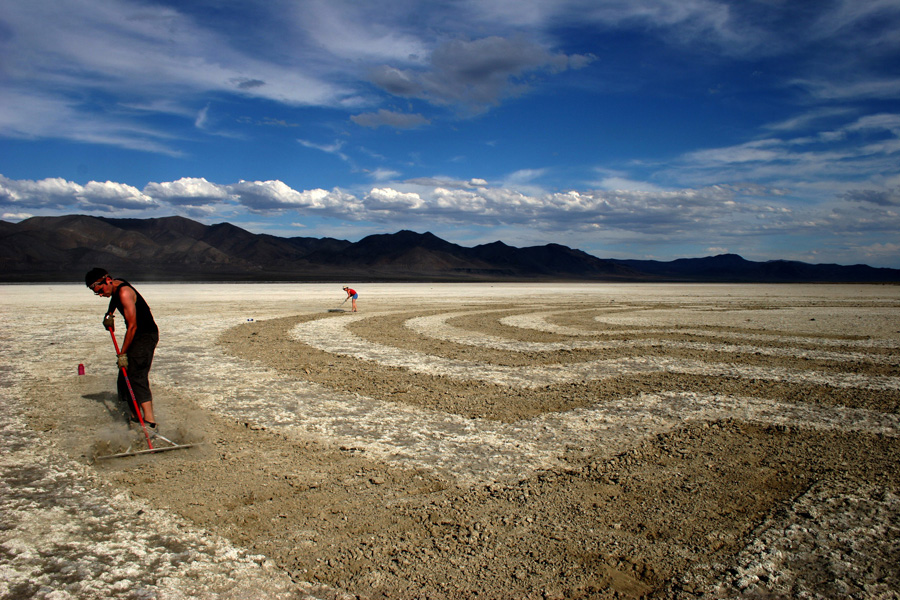
Winnemucca Whirlwind, 2008
Carbon Sink (2011), placed on the grounds of the University of Wyoming, hit a raw nerve with the local coal industry and state legislators – Wyoming is home to the US’s largest coal mine and the state benefits from the taxes on this industry. Carbon Sink is a tangible, concrete metaphor of the destruction of forests by pine beetles due to climate change. The piece, 14m in diameter, is made from beetle-killed pine logs and coal. Both these materials, once living trees, died during times of climate warming. At present, the burning of fossils fuels is giving rise to ‘warmer winters in the Rockies, as a result the pine beetle survive the winters and the forests in the Rockies are dying from New Mexico to British Columbia – a catastrophic event…Children born now will never know what a wild Mountain Forest looks like, and there will be fires and erosion in the mountains which will effect all living things’ (http://chrisdrury.co.uk/carbon-sink/)

Carbon Sink, 2010
As well as large outdoor works with environmental and cultural resonance, Drury creates impressive sculptures and installations for galleries, again from natural materials. Mushroom Cloud (2010, 2.3m x5m) was made from 6000 dried fungi slices set in acrylic and suspended by nylon wire from a steel shell at The Malaga Costa Barn, Sella Arts, Sella Valley, Italy. A beautiful, haunting work that looms above the viewer and draws associations between natural and human realms – the mushroom and the atomic bomb.

Mushroom Cloud, 2010
Heart of Stone (2004, 500x830x30 cm), exhibited in the Stephen Lacey Galley, London, uses thousands of fragments of slate laid within a wood frame. The whirlpool form of Heart of Stone is taken from blood flow patterns in the heart, and is similar to a public artwork Drury created at the Russell Hall Hospital, Dudley, UK.

Heart of Stone
Filed under Art, Arts, Earth, Environmentalism, imagination, installation art, natural world, Nature, public art, Sculpture, Uncategorized
The Cuban-American artist Ana Mendieta (1948-85) is known for her performance art, ‘earth-body sculptures’, photographs and video work, much of which centred on her own body. She was born in Havana, but during the political upheaveals of the early 1960s, she and her sister (along with many Cuban children) were sent to the United States under ‘Operation Peter Pan’, ending up in an orphanage. This dramatic exile, separating her (at age thirteen) from family and homeland, had a formative influence on her art.
Mendieta’s haunting ‘Siluetas’ (1973–81) are among her most powerful works, a fusion of performance and earth art. In these untitled sculptures, Mendieta burnt, dug or otherwise shaped her own silhouette into different outdoor sites. Often she filled in the silhouette with ephemeral materials – flowers, twigs, leaves, fire, gunpowder, candles. Sometimes her body itself, covered with flowers or mud, formed the silhouette. Interested in the earth as a site to address feelings of displacement, she recorded the presence of her body – or the imprint it left – within various environments.
In a 1981 statement about the work, she wrote: “I have been carrying out a dialogue between the landscape and the female body (based on my own silhouette). I believe this has been a direct result of my having been torn from my homeland (Cuba) during my adolescence. I am overwhelmed by the feeling of having been cast from the womb (nature). My art is the way I re-establish the bonds that unite me to the universe … Through my earth-body sculptures I become an extension of nature and nature becomes an extension of my body.”
The Silueta works – about a hundred in total – were performed as she traveled between her home in Iowa and Mexico during the period 1973-81. As the sculptures were transitory, the documenting photographs and films are considered the artworks.
In the photographs, red flowers or red powder glow against sand, soil or stone; flames burn against the earth. Mendieta drew on knowledge about indigenous rituals and beliefs, including the deities (orishas) of the Afro-Cuban religion of Santería. One beach sculpture consists of red bouganvillea blossoms in the shape of the artist’s body with arms raised; another shows incoming waves covering the silhouette on the sand. For those familiar with Santeria, the symbolism is apparent: Chango, a principal orisha, is represented by the colour red; his mistress, Yemaya, is orisha of the ocean – the frothy white waves represent her lacy petticoats.
Mendieta died in 1985 when she mysteriously fell from a 34-storey building at the age of 36, just as her work was becoming recognised outside the specialised world of feminist art criticism. Her Silueta series in particular remains a powerful body of work, an evocative testament to the effects of displacement and to the importance for this artist of an emotional connection to nature.
Filed under Art, Arts, Environmentalism, imagination, Mexico, natural world, Nature, Performance art, Photography, Sculpture, sea, the sea
The British artist Anna Gillespie (1964) makes figurative sculpture based on the human form. The focus of her work is on emotion, simplicity of form and our relationship to and experience of nature. Antony Gormley is a significant influence as is Francis Bacon, whose paintings helped her clarify how emotional injury can be conveyed through figuration. Gillespie’s figures often reflect the fragility and vulnerability of human beings and being human.
Although she works in media like stone, bronze and even duct-tape, an emphasis has been on sculptures made from ephemeral natural materials. Taste the Rain (2007) is a beautiful example. “This is part of an ongoing series of work using material that has fallen from trees: acorns, beechnut casings, leaves, bark, sycamore keys….For this piece, I found the bark in a wood near my home in the south west of England, from a fallen tree.”
“All these works try to express a moment of connection to nature and this particular piece is about trying to draw the viewer into recalling what it feels like to stand out in the rain and engage their senses.”
“Trees have a skin and so do we. Trees stand up tall and so do we. Trees stand in the rain. This piece asks us to reconnect with this experience which we all share, narrowing the gap between the trees experience and our human experience of nature.”
She also places an emphasis on honouring the unconscious processes involved in making artworks. “One of the crucial things about letting the unconscious have its say is that, being a sculptor of the human body, breathing ‘life’ into inert materials is at the heart of my work. I take inert materials, whether it be clay, masking tape, acorns or plaster, and I make something that for a moment people might believe is sentient, has feelings. Whilst actually what is happening is that our own feelings can be projected into an object, just for a minute the reality is different and a magic transformation happens. The object, the figure, contains life.”
More information and images can be found on her website http://www.annagillespie.co.uk
Filed under Art, Arts, contemporary art, Earth, Environmentalism, Myth, natural world, Nature, poetry